{{currentView.title}}
June 13, 2024
Africa File, June 13, 2024: Houthi-Shabaab Weapons Deal; SFG Boost in Central Somalia
Data Cutoff: June 13, 2024, at 10 a.m.
To receive the Africa File via email, please subscribe here. Follow CTP on Twitter, LinkedIn, and Facebook.
The Africa File provides regular analysis and assessments of major developments regarding state and nonstate actors’ activities in Africa that undermine regional stability and threaten US personnel and interests.
Key Takeaways:
- Gulf of Aden. US intelligence claimed that the Houthis and al Shabaab have discussed a deal for the Houthis to provide weapons to al Shabaab. The two groups have indirect connections through regional illicit arms networks that would likely facilitate indirect talks. Direct talks would indicate that the groups are interested in exchanging higher-grade systems not typically exchanged in the Gulf of Aden smuggling network, such as surface-to-air missiles and attack drones. The two groups are unnatural partners due to their stark sectarian differences and a lack of common targets that advance both groups’ local military aims, which are obstacles to significant cooperation outside the regional weapons-smuggling network. However, they still have some shared connections through the Axis of Resistance and al Qaeda networks that could facilitate opportunistic cooperation based on their shared anti-American interests.
- Somalia. Somali forces repelled a large-scale al Shabaab attack in central Somalia, which may enable them to retake the initiative and recapture key frontline towns. Al Shabaab has used these towns as a buffer and staging ground since it captured them in 2023. However, the Somali Federal Government (SFG) still faces lingering military and political challenges that could hamper a renewed offensive.
- Niger. Russian media amplified claims from a low-level Nigerien official calling for a Russian military base in Niger, likely to highlight grassroots support for the Russian military in Niger outside the Nigerien junta. Russia and the Nigerien junta could use this narrative in the future to set conditions for and justify a potential Russian base in Niger. CTP has previously assessed that Russia would use bases in Niger to close logistics gaps in its current network in Africa during the short term and create various threats to NATO’s southern flank in the Mediterranean and Europe in the long term.
Assessments:
Gulf of Aden
US intelligence claimed that the Houthis and al Shabaab have discussed a deal for the Houthis to provide weapons to al Shabaab. US intelligence officials told CNN on June 11 that they had not found any direct evidence of weapons transfers.[1] US officials said any potential deal would provide needed revenue for the Houthis and more advanced weapons systems for al Shabaab while advancing both groups’ anti-US goals in the Gulf of Aden.[2]
The two groups have indirect connections through regional illicit arms networks that would likely help facilitate indirect talks. Al Shabaab already has Iranian small arms intended for Yemen and shares mutual contacts with the Houthis through both groups’ involvement in the Gulf of Aden smuggling network. The Global Initiative Against Transnational Organized Crime (GITOC) wrote in a 2020 report that some weapons al Shabaab acquired from the Yemen-Somalia network come directly from Iranian shipments to Yemen meant for the Houthis.[3] The report notes that this is more likely due to profit-seeking arms traffickers than Iran- or Houthi-sanctioned supply to al Shabaab.[4] However, GITOC’s investigation also found that at least one Houthi official involved in the illicit network had direct contact with a Somali weapons smuggler who had imported arms to the IS affiliate that operates in the same areas as al Shabaab in northern Somalia.[5]
Figure 1. Somalia-Yemen Arms Smuggling Network in the Gulf of Aden
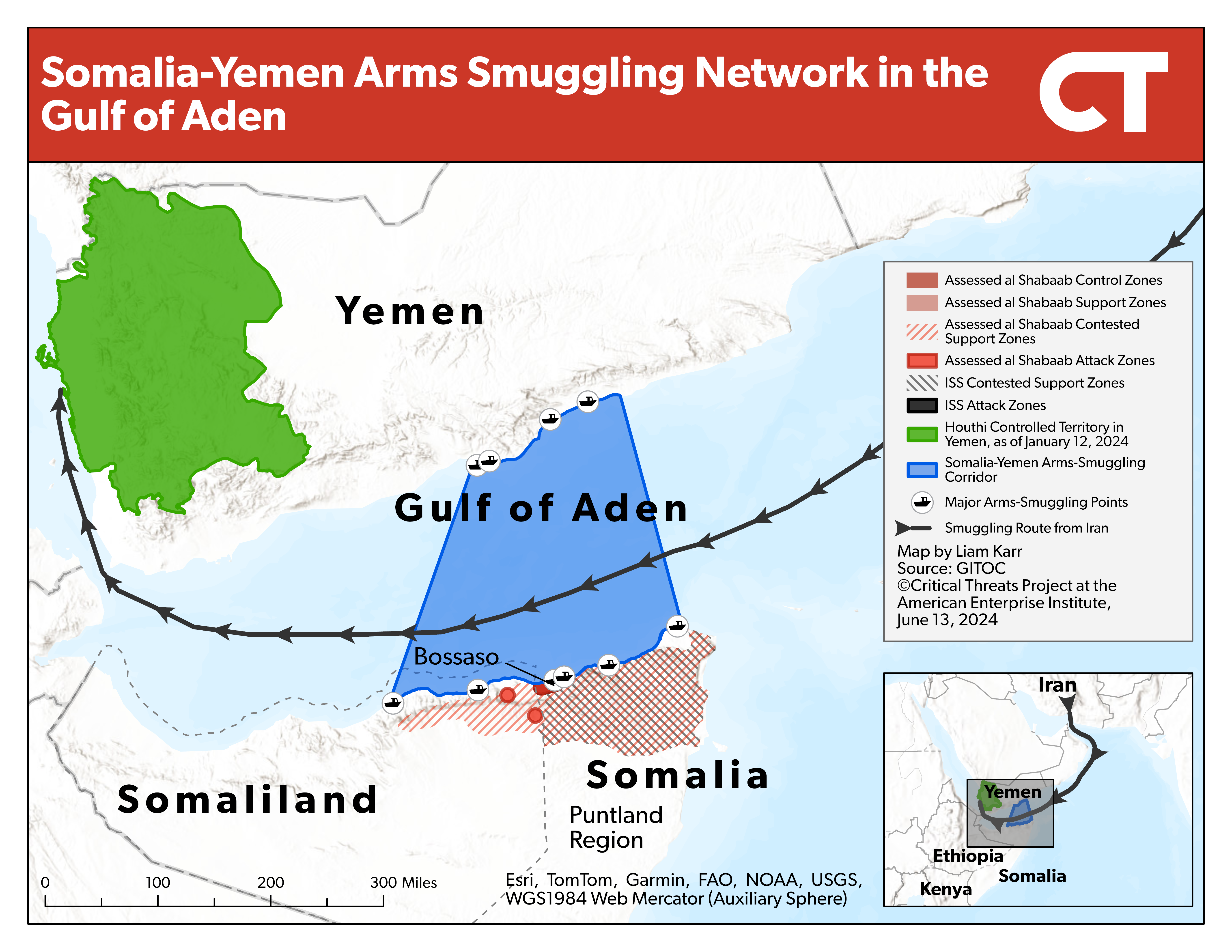
Note: “ISS” stands for Islamic State Somalia Province.
Source: Liam Karr; Global Initiative Against Transnational Organized Crime.
Direct talks between al Shabaab and the Houthis would indicate the groups are interested in exchanging higher-grade systems not typically exchanged in the Gulf of Aden smuggling network, such as surface-to-air missiles (SAMs) and attack drones. US officials indicated that the Houthis would send a “bigger kit” of weaponry than rockets and mortars.[6] Small arms, light weapons, and surveillance drone sales pose limited returns for high risk for both al Shabaab and the Houthis.
Al Shabaab is presumably willing to risk international retaliation for working with the Houthis and potential internal criticism for cooperating with an Iran-backed Shi’ite faction only if it acquires sophisticated weapons that it does not already have access to. Similarly, the Houthis are presumably willing to risk even greater international scrutiny and internal criticism for working with an al Qaeda affiliate only if it substantially advances its goals in the region. Small arms, light weapons, and surveillance drones fall short of these expectations due to al Shabaab’s preexisting access and these weapons’ limited ability to threaten US activity in Houthi domains.
The Houthis have SAMs and attack drones that address these various interests. The Houthis began shooting down MQ-9 multipurpose US drones in 2017 by modifying Soviet-era SAM stockpiles with Iranian assistance.[7] The group has since upgraded to Iranian-provided SAM systems, which has helped it increase its shoot-down rate since it began attacking shipping in the Red Sea after October 7, including downing three drones in late May.[8]
The Houthis have also used Qasef series loitering munitions, which have similar Iranian versions, since 2016. The lowest-end Qasef drones have a range of 200 kilometers, and the Houthis have used them to strike Patriot air defense systems in Saudi Arabia and detonate above soft targets in southern Yemen.[9] The drones are cheap, easy to manufacture, easily transportable, and require relatively little supporting logistics to operate, making them ideal for al Shabaab use.[10] The Houthis also have higher-end drone series, but the Qasefs would be a significant boost to al Shabaab’s capabilities without degrading higher-end Houthi capabilities.
However, the Houthis are unlikely to send advanced weapons systems, such as anti-ship ballistic and cruise missiles, to al Shabaab. The Houthis would have to provide al Shabaab with substantial training and logistical assistance to enable the group to use and maintain such weapons. Such requirements would include but are not limited to training to effectively launch and maintain the systems, logistical assistance in providing and storing fuel, and launch pads. This effort would necessitate sending trainers and additional supplies to Somalia or having al Shabaab militants train in Yemen, all of which adds additional risk for both groups. The Houthis would also presumably be more reluctant to send a nascent and potentially volatile partner these more valuable and harder-to-replace systems.
Al Shabaab would likely use Houthi-provided attack drones and SAMs to target US systems and allied personnel. Al Shabaab SAMs would target the US drones that regularly monitor and strike al Shabaab militants throughout Somalia in support of the SFG.[11] This would enable al Shabaab to degrade US and partnered intelligence collection and strike capabilities, which would strengthen al Shabaab’s freedom of movement throughout the country.
Al Shabaab would presumably use the attack drones to target Somali and allied positions throughout the country. Houthi attacks on fixed defense infrastructure and other military targets in Yemen provide a template for how al Shabaab could use this against fixed positions housing Somali or partner military forces, including African Union and US personnel.[12] The attack drones would likely fill a similar tactical role as al Shabaab’s suicide bombers, which the group uses for similar purposes to loitering munitions. It primarily uses person-borne suicide bombers to target softer targets in government-controlled areas, while it uses suicide vehicle-borne improvised explosive devices (SVBIEDs) to breach hardened bases in infantry assaults.[13]
The group could also use attack drones to target US ships in the Gulf of Aden. Attacking US naval assets would not directly advance al Shabaab’s military objectives in Somalia due to their noninvolvement in US support for the SFG’s fight against al Shabaab. However, such attacks would be a propaganda boost for the group. Al Shabaab views the United States as a key enemy due to its support to the SFG and other countries fighting al Shabaab.[14] This leads it to regularly threaten the United States, and it has highly publicized the rare instances it attacks US forces in the Horn of Africa.[15]
The two groups are unnatural partners due to their stark sectarian differences, which is a significant obstacle to significant cooperation outside the regional weapons-smuggling network. However, they still have some shared connections through the Axis of Resistance and al Qaeda networks that could help facilitate opportunistic cooperation based on their shared anti-American interests. The Houthis’ patron, Iran, and al Shabaab’s parent organization, al Qaeda, already have a well-established relationship despite being on radically opposite sides of the Shi’a-Sunni divide. Iran provided sanctuary, training, weapons, and funds to al Qaeda throughout the 1990s into the early 2000s.[16]
Al Qaeda has more recently used Iran as a key facilitation hub and sanctuary for leadership and funds since the 2010s after a crackdown in the mid-2000s.[17] UN member states and the FBI all report that al Qaeda’s current leader resides in Iran, highlighting their unique relationship.[18] This transactional partnership allows Iran to maintain leverage with al Qaeda to dissuade attacks against itself or Shi’ite communities while enabling al Qaeda to better strike their shared adversary—the United States.[19] US officials said they are exploring potential Iranian involvement in the Houthi-Shabaab arms talks but have not found any direct ties.[20]
The Houthis have established a transactional partnership with another al Qaeda affiliate, the Yemen-based al Qaeda in the Arabian Peninsula (AQAP). The two groups have cooperated on prisoner swaps since 2015.[21] The Telegraph reported in May 2024 that the Houthis had expanded cooperation to include limited military support and cooperation with AQAP since 2022 to weaken Emirati-backed forces in southern Yemen.[22] Independent analysts and Emirati-backed Yemeni military officials also claim the Houthis provided AQAP with unspecified one-way attack drones in 2023 as part of this effort.[23] AQAP also has direct ties with al Shabaab through the al Qaeda network and has historically provided al Shabaab with explosives capabilities.[24] These relationships set a precedent for Houthi cooperation with other al Qaeda affiliates, such as al Shabaab, and highlight AQAP’s role as a potential intermediary within the al Qaeda network.
The lack of common targets that advance both groups’ local military aims is another obstacle to significant cooperation. Al Shabaab attacks on US drones in Somalia would not directly help the Houthis. US Africa Command (AFRICOM) is responsible for US operations in Somalia, whereas US Central Command (CENTCOM) heads US activity in Yemen and the Red Sea. Inversely, al Shabaab attacks on US naval systems would target CENTCOM resources, which would help the Houthis but not degrade AFRICOM’s capabilities in Somalia. US officials’ statements that the Houthis are primarily engaged in talks for revenue reasons could indicate that this tension is not a significant factor and that the Houthis do not care what al Shabaab targets, as long as the Houthis receive funds.
Al Shabaab may also be unable to safely transfer weapons shipments from northern Somalia to southern Somalia, which would limit their usefulness. Most weapons that arrive in Somalia through the Somalia-Yemen trade route arrive in northern Somalia.[25] Al Shabaab primarily uses this area as a financial and logistics hub that supports its primary area of operations in central and southern Somalia. The group has been increasingly clashing with the IS Somali affiliate in this area, already restricting its freedom of movement and ability to support this effort.[26] The SFG has also degraded al Shabaab’s ability to freely move supplies between central and southern Somalia since an offensive in 2022 split the group’s support zones in central and southern Somalia.[27]
Somalia
Somali forces repelled a large-scale al Shabaab attack in central Somalia. Al Shabaab launched a complex attack involving SVBIEDs, targeting the district capital El Dheere in central Somalia’s Galgudud region on June 8.[28] The attack commenced with SVBIEDs followed by infantry assaults targeting the two army bases in the town.[29] Al Shabaab initially overran at least one of the camps, but defending forces received reinforcements from nearby towns and air support that helped repel the attack and mop up retreating militants.[30] The SFG claimed to kill 47 militants, while al Shabaab claimed to kill 57.[31] Somali officials have since visited the town to commend the troops.[32]
Somali forces may be able to use this momentum to retake the initiative and recapture several towns al Shabaab currently controls that serve as a buffer and staging ground between the SFG-controlled district capitals and the al Shabaab–controlled district capital in central Somalia. The SFG has been preparing since April to retake the initiative in central Somalia for the first time since August 2023.[33] Such efforts have included political components such as consultative meetings between SFG parliamentarians, security officials, and clan elders.[34] The SFG and its international partners have also tried to set military conditions for a renewed offensive by increasing air strikes on nearby al Shabaab support zones.[35]
Al Shabaab recaptured several key frontline towns after thwarting an SFG offensive to capture the last al Shabaab–controlled district capital, El Bur, in August 2023. Somali forces reached the town but were overextended, leaving a string of weakly defended forward operating bases in the rural areas they cleared to reach the town.[36] Al Shabaab regrouped and overran one of these bases, inflicting significant casualties and causing the SFG’s position to disintegrate, isolating El Bur and forcing Somali forces to withdraw from it and several other rural villages.[37] Al Shabaab has since used these rural areas to isolate the SFG-controlled district capitals and stage large-scale attacks on SFG bases throughout the region.[38]
Figure 2. Somali Forces and al Shabaab Contest Central Somalia
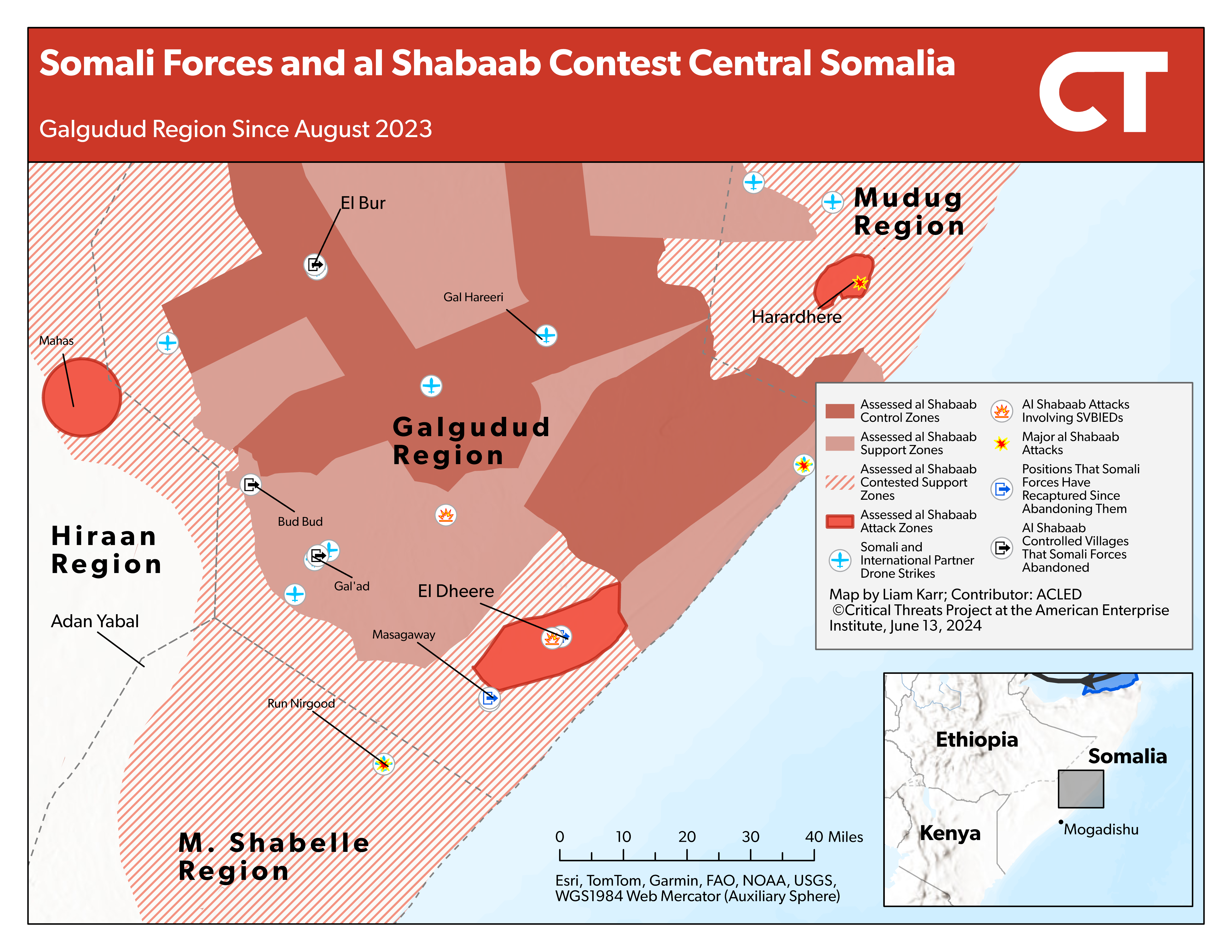
Source: Liam Karr; Armed Conflict Location Event and Data Project.
The SFG still faces lingering military and political challenges that could hamper a renewed offensive. Clan tensions are still present across central Somalia and limit the anti–al Shabaab coalition’s cohesion.[39] Al Shabaab played on this tension to peel local support away from the government throughout 2023.[40] Unified clan support was crucial to the SFG’s initial success in 2023.[41]
The SFG has also not shown it can consistently repel al Shabaab’s SVBIED attacks. Al Shabaab has used these attacks to stymie multiple SFG offensives to clear the group’s remaining havens in central Somalia in January, April, and August 2023.[42] Somali forces and international partners will have to maintain pressure on al Shabaab staging areas and cut al Shabaab resupply lines that enable the group to support its fighters in central Somalia.[43]
Al Shabaab has also retaken territory farther south near Mogadishu that enables it to pressure SFG supply lines. The group reestablished a foothold in the Shabelle River Valley in early 2024, enabling it to pressure supply lines connecting Mogadishu and central Somalia.[44] It took Somali forces over a month to clear a previous foothold in the same area with African Union support in 2023.[45]
Niger
Russian media amplified claims from a low-level Nigerien official calling for a Russian military base in Niger, likely to highlight grassroots support for the Russian military in Niger outside the Nigerien junta. Russian media widely published statements from Russian Honorary Consul in Niger Addo Iro that Niger was interested in hosting a “full-fledged” Russian military base.[46] The consul said this would help Niger in the fight against growing terrorism.[47] Honorary consuls are typically citizens of host countries (e.g., Niger) who undertake honorary diplomatic activity on behalf of the representative country (e.g., Russia) that aims to promote economic, cultural, and educational ties between the two countries. Honorary consuls are specifically not entrusted with diplomatic and political functions. A Kremlin-linked milblogger specifically noted that no concrete talks have taken place and that the report is “primarily intended to refute information attacks in the Western media that the main task of the Russian Armed Forces in the country is supposedly to seize American bases.”[48]
Russia and the Nigerien junta could use this narrative in the future to set conditions for and justify a potential Russian base in Niger. CTP has assessed since March 2024 that Russian troops would likely backfill departing US troops, who are now scheduled to finish withdrawing by September 15. Russian Africa Corps soldiers stated their intentions to replace US forces in northern Niger when they arrived in April and entered a base housing US military personnel in the country in May 2024.[49] US officials have noted that departing troops would be leaving behind stationary or bulky items such as hangars, housing units, generators, and other infrastructure that would presumably benefit future forces.[50]
Russian Deputy Defense Minister Yunus Bek Yevkurov also visited Niger on June 2 and signed an agreement with Nigerien officials. Russian media initially described the deal as a “multi-sectoral” agreement and mentioned the visit in their June 11 reports to highlight growing ties with Niger. This rhetoric explicitly links to the general discussions around Russian basing in Niger to more tangible military activity, as Russian media used the same terminology to describe the December 2023 agreement that paved the way for the initial Africa Corps deployment.[51]
CTP has previously assessed that Russia would use bases in Niger to close logistics gaps in its current network in Africa in the short term and create various threats to NATO’s southern flank in the Mediterranean and Europe in the long term. Africa Corps taking over the US base in Agadez, northern Niger, would put a Russian base 1,100 miles or less from the Russian-controlled air bases in Libya to the north and just over 1,100 miles from major Russian bases in the Malian capital to the west and the Central African Republic capital to the southeast.[52] Russian control of the drone base would also create the opportunity for Russia to directly threaten NATO operations in the Mediterranean Sea with versions of the mass-produced Shahed-136 attack drone or foment increased migrant flows that destabilize Europe.[53]
Figure 3. Russian Military Facilities in Northwest Africa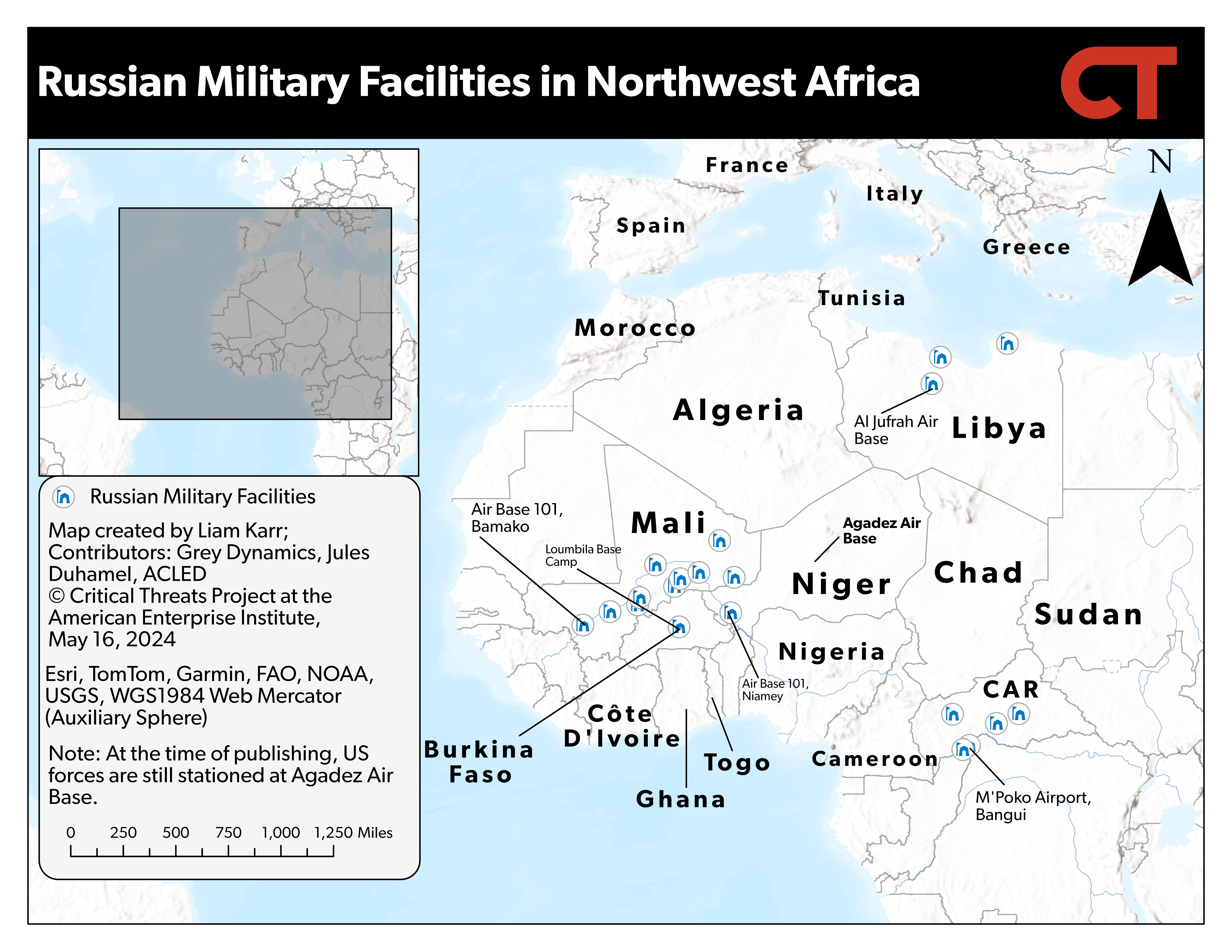
Note: “CAR” stands for Central African Republic.
Source: Liam Karr; Grey Dynamics; Jules Duhamel; Armed Conflict Location and Event Data Project.
Figure 4. Growing Russian Presence on Trans-Saharan Migration Routes in West Africa
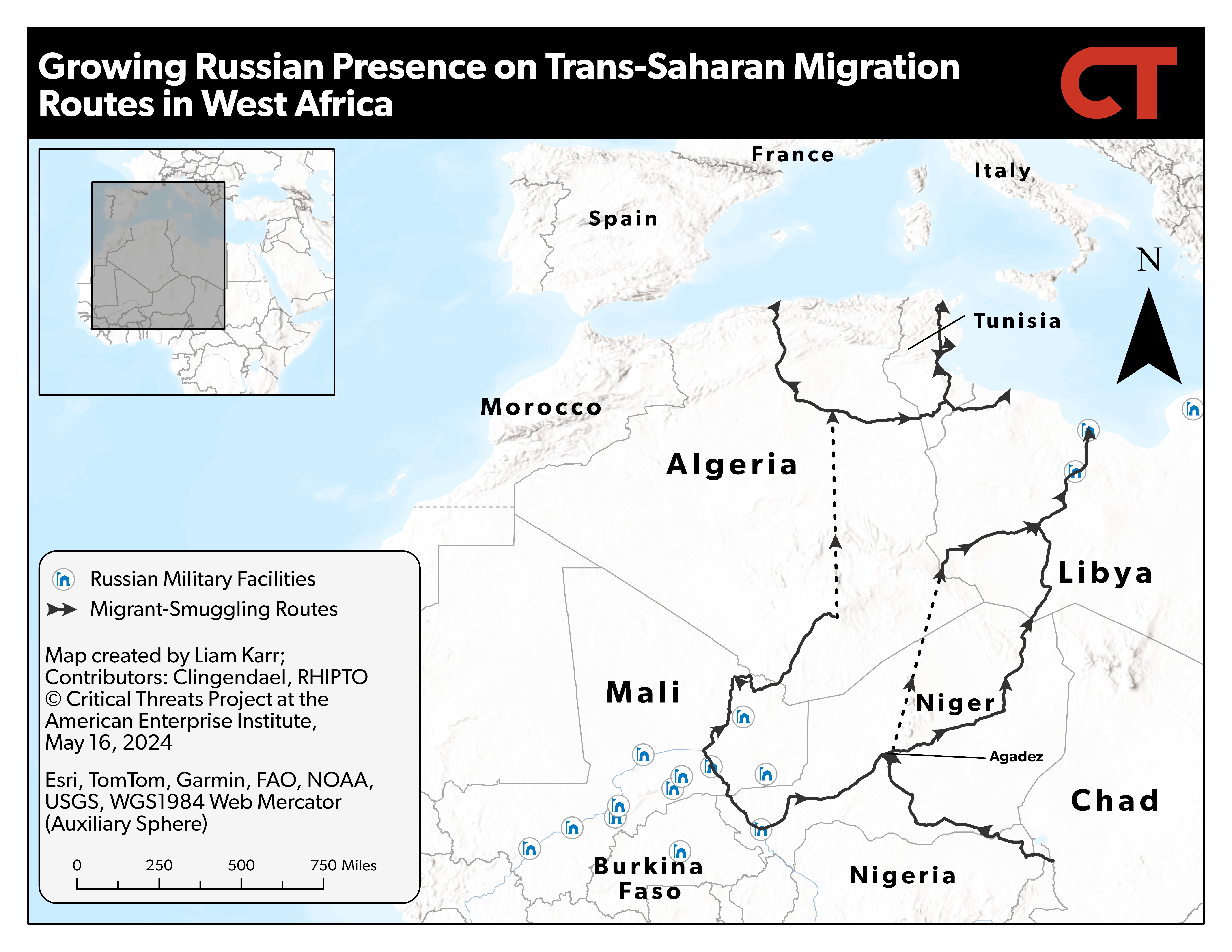
Source: Liam Karr; Clingendael Institute; Norwegian Center for Global Analyses.
Figure 5. Prospective Range of Iranian-Made Shahed-136 Drones from Agadez, Northern Niger
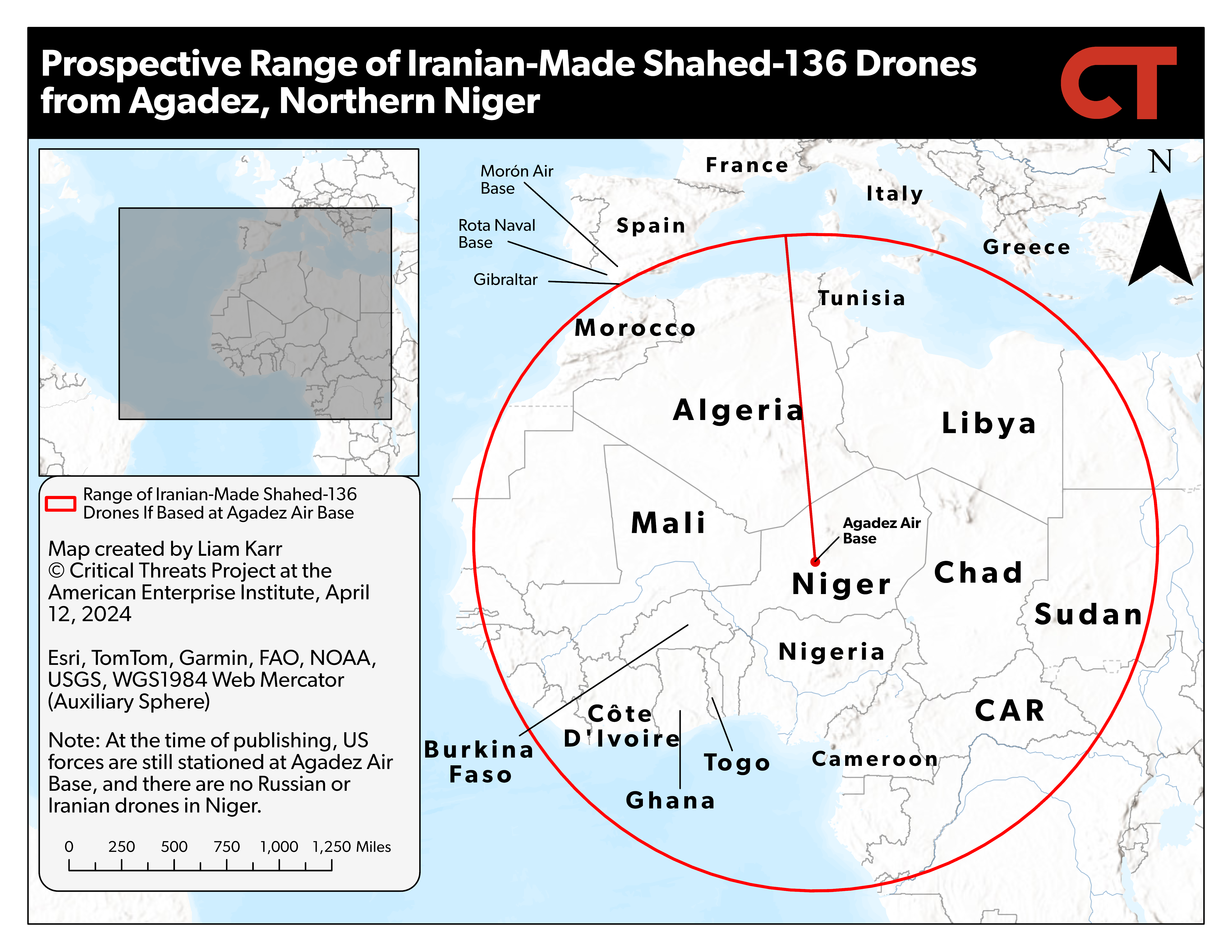
Note: At the time of publishing, US forces are still stationed at Agadez Air Base, and there are no Russian or Iranian drones in Niger. “CAR” is Central African Republic.
Source: Liam Karr.
[1] https://www.cnn.com/2024/06/11/politics/us-intelligence-houthis-al-shabaab/index.html
[2] https://www.cnn.com/2024/06/11/politics/us-intelligence-houthis-al-shabaab/index.html
[3] https://globalinitiative.net/analysis/yemen-somalia-arms
[4] https://globalinitiative.net/analysis/yemen-somalia-arms
[5] https://globalinitiative.net/analysis/yemen-somalia-arms
[6] https://www.cnn.com/2024/06/11/politics/us-intelligence-houthis-al-shabaab/index.html
[7] https://www.aei.org/research-products/report/yemens-houthis-and-the-expansion-of-irans-axis-of-resistance
[8] https://news.usni.org/2024/02/07/dia-report-on-iranian-arms-used-by-houthi-forces; https://ctc.westpoint.edu/assessing-the-houthi-war-effort-since-october-2023; https://www.voanews.com/a/third-us-reaper-drone-goes-down-in-yemen-according-to-houthi-images/7634026.html; https://apnews.com/article/yemen-houthis-us-drone-war-gaza-7bbbcd1a1484baf581832da6f4d4dd18
[9] https://www.aei.org/research-products/report/yemens-houthis-and-the-expansion-of-irans-axis-of-resistance
[10] https://www.fpri.org/article/2019/01/low-tech-high-reward-the-houthi-drone-attack
[11] https://www.newamerica.org/future-security/reports/americas-counterterrorism-wars/the-war-in-somalia
[12] https://www.aei.org/research-products/report/yemens-houthis-and-the-expansion-of-irans-axis-of-resistance
[13] https://www.jstor.org/stable/resrep17361.6; https://extremism.gwu.edu/sites/g/files/zaxdzs5746/files/Al-Shabaab-IMEP_Bacon_March-2022.pdf
[14] https://extremism.gwu.edu/sites/g/files/zaxdzs5746/files/Al-Shabaab-IMEP_Bacon_March-2022.pdf
[15] https://extremism.gwu.edu/sites/g/files/zaxdzs5746/files/Al-Shabaab-IMEP_Bacon_March-2022.pdf
[16] https://www.brookings.edu/articles/unlikely-alliance-irans-secretive-relationship-with-al-qaeda; https://www.brookings.edu/articles/the-al-qaeda-iran-connection; https://www.lawfaremedia.org/article/making-sense-iran-and-al-qaedas-relationship
[17] https://www.brookings.edu/articles/unlikely-alliance-irans-secretive-relationship-with-al-qaeda; https://www.brookings.edu/articles/the-al-qaeda-iran-connection; https://www.lawfaremedia.org/article/making-sense-iran-and-al-qaedas-relationship
[18] https://www.voanews.com/a/us-backs-un-assessment-that-new-al-qaida-leader-is-in-iran/6965397.html; https://extremism.gwu.edu/al-qaeda-de-facto-leader-sayf-al-adl; https://www.fbi.gov/wanted/wanted_terrorists/saif-al-adel-1/@@download.pdf
[19] https://www.lawfaremedia.org/article/making-sense-iran-and-al-qaedas-relationship; https://www.arabnews.com/node/2256736
[20] https://www.cnn.com/2024/06/11/politics/us-intelligence-houthis-al-shabaab/index.html
[21] https://sanaacenter.org/publications/analysis/16002
[22] https://www.telegraph.co.uk/world-news/2024/05/04/houthis-team-up-feared-al-qaeda-branch-new-threat-yemen
[23] https://www.lawfaremedia.org/article/al-qaeda-in-the-arabian-peninsula-s-drone-attacks-indicate-a-strategic-shift; https://www.telegraph.co.uk/world-news/2024/05/04/houthis-team-up-feared-al-qaeda-branch-new-threat-yemen
[24] https://extremism.gwu.edu/sites/g/files/zaxdzs5746/files/Al-Shabaab-IMEP_Bacon_March-2022.pdf
[25] https://globalinitiative.net/analysis/yemen-somalia-arms
[26] https://www.criticalthreats.org/analysis/africa-file-april-25-2024-is-somalia-expansion-benefits-is-global-network-togo-constitutional-changes#Somalia
[27] https://www.crisisgroup.org/africa/horn-africa/somalia/b187-sustaining-gains-somalias-offensive-against-al-shabaab
[28] https://www.bbc.com/somali/articles/cyddgm630p3o
[29] https://x.com/HarunMaruf/status/1799430357470585149
[30] https://x.com/HarunMaruf/status/1799493023153172892; https://garoweonline dot com/en/news/somalia/somalia-el-dheer-still-in-under-sna-despite-al-shabaab-upset
[31] https://x.com/HarunMaruf/status/1799483743364661267; https://x.com/HarunMaruf/status/1799430357470585149
[32] https://x.com/GoobjoogMedia/status/1800128073251148140
[33] https://www.voasomali.com/a/ileyska-voa-dowladda-federaalka-oo-duulaan-cusub-ku-qaadaysa-al-shabaab/7608905.html; https://thesomalidigest dot com/sna-struggles-to-reclaim-previously-liberated-territory-as-deputy-commander-promises-al-shabab-defeat-in-june
[34] https://www.hiiraan dot com/news4/2024/May/196250/nisa_director_federal_lawmakers_start_al_shabab_meetings_in_beledweyne_town.aspx; https://www.facebook.com/watch/?v=451247300784682
[35] https://acleddata.com/2024/05/31/somalia-situation-update-march-2024-renewed-counter-insurgency-operations-expected-as-al-shabaab-regroups
[36] https://www.voanews.com/a/somali-army-captures-elbur-district-a-major-al-shabab-base/7241788.html
[37] https://www.voanews.com/a/7245333.html; https://www.caasimada dot net/deg-deg-ciidamada-df-oo-degmo-cusub-kala-wareegay-al-shabaab
[38] https://thesomalidigest dot com/al-shabab-seizes-caad-casualties-reported; https://www.hiiraan dot com/news4/2024/Feb/194875/somali_army_kills_25_al_shabab_militants_in_foiled_attack_in_mudug_region.aspx; https://shabellemedia dot com/al-shabaab-raid-on-sna-fob-led-to-intense-combat-in-somalia; https://www.garoweonline dot com/en/news/somalia/al-shabaab-carries-out-attack-in-central-somalia
[39] https://thesomalidigest dot com/clashes-escalate-in-adale-raising-concerns-of-impending-clan-war; https://www.caasimada dot net/dagaal-culus-oo-ka-qarxay-gobolka-galgaduud-iyo-wararkii-ugu-dambeeyay; https://thesomalidigest dot com/danab-and-macawisley-clash-in-middle-shabelle-region
[40] https://acleddata.com/2024/05/31/somalia-situation-update-may-2024-renewed-counter-insurgency-operations-expected-as-al-shabaab-regroups
[41] https://www.crisisgroup.org/africa/horn-africa/somalia/b187-sustaining-gains-somalias-offensive-against-al-shabaab
[42] https://www.caasimada dot net/al-shabab-launches-surprise-attack-on-somali-military-base; SITE Intelligence Group, “Shabaab Claims over 159 Killed in Raid on Danab Special Forces Base in Galguduud,” January 20, 2023, available by subscription at www.siteintelgroup.com; SITE Intelligence Group, “Shabaab Video Documents Aftermath of Major Operation in Budbud Inflicting 50+ Casualties,” April 24, 2023, available by subscription at www.siteintelgroup.com; https://www.voanews.com/a/7245333.html; https://x.com/HussienM12/status/1750893221629026737?s=20; https://thesomalidigest dot com/al-shabab-seizes-caad-casualties-reported
[43] https://x.com/HShPrez2Ware/status/1707766721849786558?s=20; https://www.criticalthreats.org/analysis/salafi-jihadi-movement-weekly-update-april-27-2023#Somalia20230427
[44] https://www.criticalthreats.org/analysis/africa-file-may-2-2024-iran-pursues-economic-and-military-influence-burkinabe-abuses-mali-kills-wanted-is-commander-insurgents-strengthen-in-east-africa#Somalia; https://www.caasimada dot net/ciidamada-xoogga-dalka-oo-dib-ula-wareegay-deegaanka-cali-fooldheere; https://twitter.com/Hammrawi_/status/1784143647438492084
[45] https://www.criticalthreats.org/analysis/salafi-jihadi-movement-weekly-update-october-4-2023#SOM20231004; https://twitter.com/HarunMaruf/status/1699817775374516508; https://x.com/HarunMaruf/status/1703632032440479980?s=20; https://shabellemedia dot com/faah-faahino-ka-soo-baxay-duqeymo-ka-socda-gobolka-shabeelaha-dhexe; https://x.com/HarunMaruf/status/1709243460790759699?s=20; https://x.com/HarunMaruf/status/1708691876700626987?s=20; https://atmis-au.org/en/so-atmis-iyo-ciidanka-xoogga-dalka-soomaaliyeed-oo-sameeyey-iskaashi-milatari-ayaa-al-shabaab-ka-saaray-keymaha-cali-fooldheere
[46] https://iz dot ru/1710730/video/niger-zainteresovan-v-razmeshchenii-polnotcennoi-voennoi-bazy-rossii; https://iz dot ru/1710178/2024-06-10/v-nigere-zaiavili-o-zhelanii-razmestit-u-sebia-voennuiu-bazu-rf; https://en.sputniknews dot africa/20240610/niger-interested-in-placing-russian-military-base-on-its-territory-to-help-fight-terrorism-1066962515.html
[47] https://iz dot ru/1710730/video/niger-zainteresovan-v-razmeshchenii-polnotcennoi-voennoi-bazy-rossii; https://iz dot ru/1710178/2024-06-10/v-nigere-zaiavili-o-zhelanii-razmestit-u-sebia-voennuiu-bazu-rf; https://en.sputniknews dot africa/20240610/niger-interested-in-placing-russian-military-base-on-its-territory-to-help-fight-terrorism-1066962515.html
[49] https://x.com/casusbellii/status/1778559755046277387; https://www.reuters.com/world/africa/russian-troops-enter-base-housing-us-military-niger-us-official-says-2024-05-02
[50] https://www.washingtonpost.com/national-security/2024/05/19/us-forces-niger-counterterrorism
[51] https://tass dot ru/mezhdunarodnaya-panorama/20975865; https://fr.sputniknews dot africa/20240603/une-delegation-russe-a-niamey-pour-consolider-le-partenariat-strategique-russo-nigerien-1066855385.html
[52] https://jamestown.org/program/russian-military-intelligence-takes-over-wagner-operations-in-libya
[53] https://www.criticalthreats.org/analysis/africa-file-special-edition-russias-africa-corps-arrives-in-niger-whats-next
